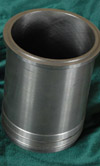The Cylinder Liner
 The humble cylinder bore seems to get very little press these days. Arguably the most critical surface in any combustion engine, the inside surface of any cylinder liner is exposed to the full flame temperature and the high pressures of combustion and yet still has to form an almost gas tight seal against the piston ring. And all this we ask with minimum wall thickness and hence minimum weight. While the more modern high performance engine designs might have any form of nickel ceramic coating over an aluminium alloy base material for light weight, low friction and optimal lubrication, it shouldn’t come as much of a surprise to most that the vast majority of cylinder blocks in use today are still fitted with cast iron cylinder liners.
The humble cylinder bore seems to get very little press these days. Arguably the most critical surface in any combustion engine, the inside surface of any cylinder liner is exposed to the full flame temperature and the high pressures of combustion and yet still has to form an almost gas tight seal against the piston ring. And all this we ask with minimum wall thickness and hence minimum weight. While the more modern high performance engine designs might have any form of nickel ceramic coating over an aluminium alloy base material for light weight, low friction and optimal lubrication, it shouldn’t come as much of a surprise to most that the vast majority of cylinder blocks in use today are still fitted with cast iron cylinder liners.
To be more exact, the material to which I refer is grey cast iron since it is grey in colour, it is iron and manufactured by casting. Easily machined, even if the resulting sward chips and flies all over the machine shop, this type of cast iron has excellent surface properties, which make it ideal for the application. And in case you think it isn’t a high performance material, let me remind you that the original Cosworth DFV engines incorporated this material in its liners. Delivering something like 400+ bhp at 10,000 rpm from the outset, there is still a strong demand for these liners on the historic scene. However for powers or speeds much greater than this, its ability to dissipate the heat generated begins to diminish.
The G1 specification cast iron used today has benefited from a further 40 years of development but these liners are still made using a centrifugal casting technique. The molten iron is poured into a rotating drum where the centrifugal force pushes the liquid mass outwards while the lower density slag, gas bubbles and impurities migrate towards the middle layers and escape such that when the metal solidifies, a fine grained homogeneous thick-walled tube results. While it might be easy to imagine that modern high performance engines would be better using stronger steel liners, cast iron has, despite its brittle nature, some admirable qualities. Principal among theses is the inclusion of graphite between the grain boundaries of the crystalline matrix. Whereas steel consists of iron with a controlled amount of carbon (normally less than 1.2%), cast iron will contain between 2-4%. In controlling the content, the melting point can be lowered making it more fluid and easier to cast but critically, allowing free carbon in the form of graphite to precipitate out. A natural lubricant, this graphite provides an excellent rubbing surface for the piston ring minimising both friction and wear. While other liners, either steel or aluminium alloy may be lighter, unlike cast iron, they all require some form of surface coating to give any form of acceptable durability.
The fitting of liners to cast iron cylinder blocks is a fairly straightforward affair. However the fitment of ‘wet’ cast iron liners into an aluminium block may require more care. In such cases, and apart from the increased level of interference fit required, the assembly may benefit from the use of Austenitic iron which alloyed with nickel and a small amount of either copper or manganese, will give a coefficient of expansion similar to that of the aluminium.
It may not be the most fashionable of materials but when the application can tolerate it, you could do worse than using cast iron in your liners. It might also save you a ‘bob’ or two.
Written by John Coxon.